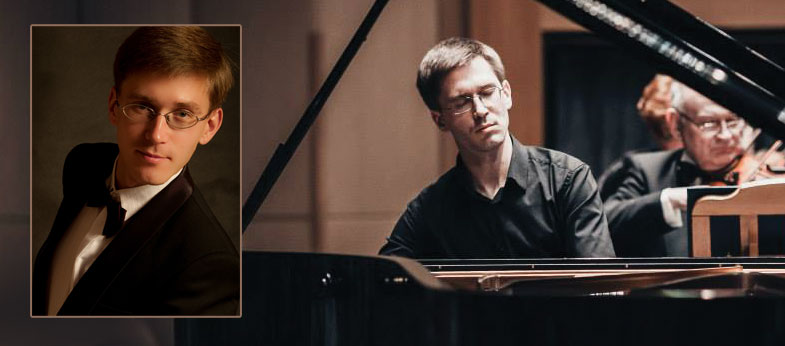

About
Vyacheslav Gryaznov (born 1982) russian classical pianist, transcriber and composer studied at the Moscow Conservatory and is now an assistant professor in the Conservatory’s Piano Department. He has won numerous prestigious competitions including the 1997 Rubinstein International Competition in Moscow (1st Prize) and the 1998 Italian “To the memory of Rachmaninov” Competition (1st Prize).
He has performed throughout Russia, Ukraine, Georgia, Asia and Europe, both in solo recitals and with chamber groups and orchestras, including the Russian Philharmonic Orchestra. He has cooperated with such major companies as the NHK Japanese Broadcasting Corporation (in a project comprising some 30 recitals, and CD and video recordings).
Mr. Gryaznov is also known as the composer of numerous concert transcriptions for piano solo, piano four-hands, and chamber groups that have become popular all over the world. In 2014 he signed a contract with Schott Music, GmbH & Co., a leading classical and contemporary music publisher. He records for the Melodiya label.
Program
Program Notes
Beethoven composed this set of variations on a Russian Dance from Carl Maria von Weber’s opera Das Waldmadchen during the year of its premiere in Vienna, 1796. It was dedicated, like the Piano Sonata Op. 10 and other variations, to Countess Anna Margarete von Browne, whose husband was an early patron. Most of the variations are written in the key of A Major, with only three in A minor. Each variation follows the pattern of a short opening theme first in the dominant key (E Major) and then the tonic, before moving to a contrasting idea and repeat of the main theme.
Debussy’s Prelude to the Afternoon of a Faun is a symphonic poem steeped in artistic expression, with the composer taking inspiration from a poem of the same name by Stéphane Mallarmé and in turn providing inspiration for the ballet Afternoon for a Faun, choreographed by the wildly celebrated Ballets Russes dancer, Nijinsky. Debussy scored the work for a more modern set of orchestral instruments: flutes (for the faun), oboes, bassoons, harps, horns and more, in addition to strings. While the beautifully and theatrically intertwined melodies depict a natural scene that seems effortless and free-form, the organization of motifs and their instruments are well structured. Where Debussy utilized orchestral tonality and harmony to paint his picture, the piano transcription relies on the instrument’s vocal range to achieve similarly broad effects.
Ravel composed Gaspard de la Nuit in 1908 to go further in writing a difficult solo piano piece. Each movement is based on a 19th century poem by Aloysius Bertrand and depicts the written scene precisely. Ondine tells of a nymph beckoning people to her lake bottom kingdom, and, therefore, the enticing murmurs of her call and the rolling of the waters are heard. Le Gibet transports listeners to the desert, where maintaining the ostinato (persistent) bass signifying a tolling bell is the pianist’s challenge. Finally, Scarbo is the virtuosic moment the pianist has been waiting for and possibly dreading, much like the poem’s narrator, who dreads the evil dwarf Scarbo. Staccato bass and frantic rhythms depict the creature’s strange idiosyncrasies, and even the calmer middle section is only a slower version of the main theme. The infamous difficulties are not just precision and technique, but also adaptability and agility. In composing this music, Ravel wrote a legendary piece that is still talked about and analyzed today.
The orchestral suite for Sergei Prokofiev’s failed 1930 ballet, Sur la Borysthene, (“On the Dnieper” [river]) focuses on six ballet numbers. The story follows Sergei, who has returned home from the First World War and finds he is no longer in love with his betrothed, Natasha, but instead with Olga. Olga is engaged to another man, and a fight ensues in which Sergei falls but is saved by Natasha. She then compassionately helps Sergei and Olga run away from the village. Another enchanting and evocative transcription by this evening’s artist, this composition transforms a ballet turned orchestral suite into a wondrous piano suite.
Sergei Rachmaninoff composed his Sonata No. 2 in 1913, but revised and shortened it in 1931, and this is the version most often performed today. The exquisiteness of this work lies not in its perfect sonata form or in any one of its lovely melodies, but rather in the seamless melding of the three movements, with their differing powers and expression, into a piece experienced as one continuous unit. No longer are themes relegated to a movement, nor do they reappear as exact repetitions. Both the second and third movements contain references to earlier themes, but the listener is too captured in the moment to recall the sonata’s cyclic nature. Immediately gratifying moments pervade the music, making this piece a delightful journey from start to end.